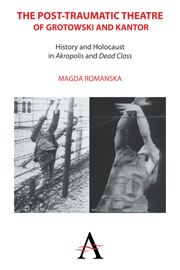 The Post-traumatic Theatre of Grotowski and Kantor
The Post-traumatic Theatre of Grotowski and Kantor from Part II - Our Memory: Kantor's Dead Class
In Dead Class, Kantor is interested in representing absence, and he does so by two aesthetic means: one, he places his actors on an equal footing with objects, thus creating his bio-objects, combinations of actor and object; and two, he models his actors on marionettes. Dead Class, however, wasn't the first work in which he explored these concepts. Kantor used mannequins in The Water Hen (1976) and The Shoemakers (1970). In his staging of Słowacki's Balladyna, Kantor had mannequins as doubles of the real actors.
In modeling his actors on marionettes, Kantor was partially influenced by the theories of Heinrich von Kleist and Edward Gordon Craig. In a pivotal essay written in 1810, “About the Marionette Theater,” Kleist introduces the idea of the intrinsic supremacy of the puppet over the human actor. On an ontological scale, Kleist locates man somewhere between God, the supreme being, and the marionette, the absence of being, both of which represent similar degrees of perfection as complete opposites of each other. The marionette's lack of consciousness and the centralization of all of its movements from one point of gravity make it an absolute and finished form, one for which nothing can be improved. Because all the puppet's movements are controlled from one point, it can be fully coordinated, creating the sort of ultimate, divine grace attainable only by that other perfection, God. For Kleist, marionettes “are members of only one world, responding ‘naturally’ and ‘gracefully’ to divine guidance. This is underscored by their apparent weightlessness.
To save this book to your Kindle, first ensure no-reply@cambridge.org is added to your Approved Personal Document E-mail List under your Personal Document Settings on the Manage Your Content and Devices page of your Amazon account. Then enter the ‘name’ part of your Kindle email address below. Find out more about saving to your Kindle.
Note you can select to save to either the @free.kindle.com or @kindle.com variations. ‘@free.kindle.com’ emails are free but can only be saved to your device when it is connected to wi-fi. ‘@kindle.com’ emails can be delivered even when you are not connected to wi-fi, but note that service fees apply.
Find out more about the Kindle Personal Document Service.
To save content items to your account, please confirm that you agree to abide by our usage policies. If this is the first time you use this feature, you will be asked to authorise Cambridge Core to connect with your account. Find out more about saving content to Dropbox.
To save content items to your account, please confirm that you agree to abide by our usage policies. If this is the first time you use this feature, you will be asked to authorise Cambridge Core to connect with your account. Find out more about saving content to Google Drive.